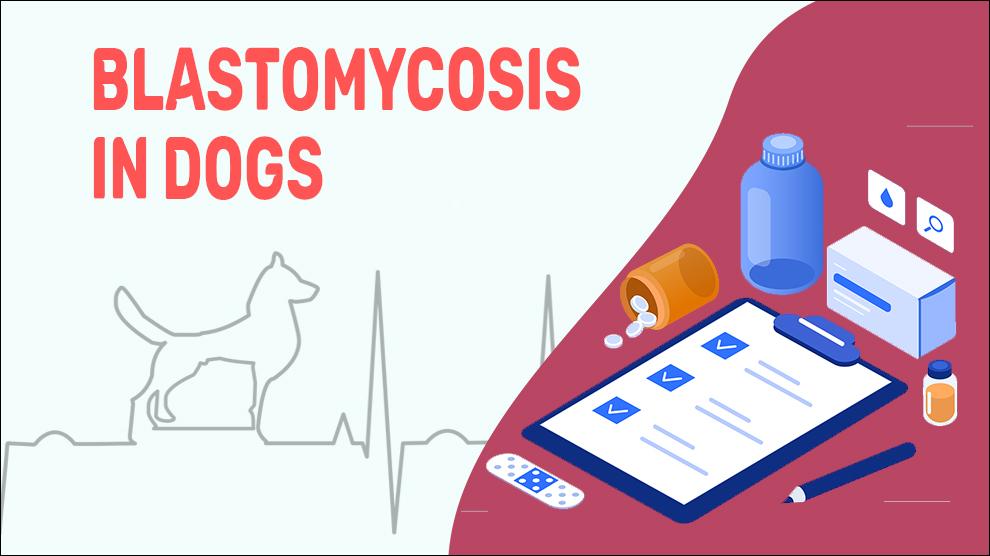What Is Blastomycosis In dogs?
Blastomycosis (also known as “Blasto”) is a systemic yeast-like fungal infection caused by the saprophytic fungus Blastomyces dermatitidis. Blastomycosis appears most commonly in certain geographic locations having moist, acidic soil that is rich in organic matter (rotting logs and vegetation) and in wet environments (such as riverbanks, lakes and swamps).
Dogs contract infection after breathing in the infective mycelial phase of Blastomyces fungus in the environment. After infection, the organism transforms to yeast at normal canine body temperature and begins to infect the lungs and spread systemically.
Blastomycosis occurs more frequently in dogs and the disease is rarely reported in cats. The reason dogs are more susceptible is unknown, but the tendency to poke their noses in the soil or following a scent trail may play a role. Airborne fungal spores of contaminated soil get disturbed and the dog inhales the spore.
Blastomycosis from dogs to humans is not yet reported. However, dermal infections from a dog’s open wound secretions are rare but reported.
What Are The Signs Of Blastomycosis In dogs?
- Coughing
- Labored breathing
- Lethargy
- Fever
- Inflammation of the eyes or sudden onset of blindness
- Uveitis, glaucoma, and retinal detachment
- Draining skin lesions
- Orchitis (testicular inflammation)
- Lack of appetite
- Enlarged lymph nodes
How Is Blastomycosis In dogs Treated?
Commonly used Anti-fungal agents are azole antifungals including itraconazole, fluconazole, voriconazole and ketoconazole. They have relatively few side effects and are well-tolerated by most dogs.
Treatment of blasto requires long-term medications (2-6 months in most cases).
Amphotericin B (Abelcet - The Liposome Company) is the "gold standard" of antifungal drugs.
Ketoconazole (less expensive than the other azole antifungals) or a combination of medications may also used in certain cases.
Home Remedies For Blastomycosis In dogs
Every dog is different in its own right.
This means that the best home remedies (such as diets) for your dog undergoing treatment for heart disease - depends on your dog.
Work with your vet to find the optimal dietary plan for your dog.
Home remedies such as herbs, diet and exercise will depend on your dog’s age and stage of disease they are in.
How To Prevent Blastomycosis In dogs?
- Sadly, there is nothing we can do to get rid of this dimorphic fungus from the environment as they are widespread.
- Avoid the Fungal Hotspots are forests, wooded areas, camps, hunting areas, and overgrown bushes. In addition, when your dog's immune system is already compromised, stay away from trips to these high-risk areas.
- Cut down the access of dogs to swamps or near water bodies where there is Decayed organic material and foliages, especially when the soil remains damp all the time and not exposed to sunlight.
- However, it is not easy to guess where the Blastomyces may be growing. When the contaminated dust is lighter, the spores are likely to go airborne during dry weather. So, it is difficult to avoid entirely.
- If you do live or spend time in areas nearby water bodies, it is an impractical suggestion to avoid them entirely but maybe practicably you can avoid the moist, swampy areas where the fungus would flourish the most.
Dog Breeds Affected By Blastomycosis In dogs
Large Dog Breeds, Small Dog Breeds
Additional Facts On Blastomycosis In dogs
- Large breed dogs with outdoor access living in endemic regions are at higher risk.
- Hunting, sporting dogs in close proximity to swamps, overturned soil (i.e., farms, construction sites) or bodies of water seem to be predisposed to the disease.
- Canine Blastomycosis is not spread from animal to animal and is not contagious.
- Most cases of blastomycosis are diagnosed in early fall or late summer in the endemic regions.
When To See A Vet For Blastomycosis In dogs?
In many cases of blastomycosis infection, Prognosis is good with recovery rates between 50-75%. Survival rate depends on severity of signs and overall health of the dog. Severity of lung diseases and CNS involvement are two important negative prognostic factors.
The decisive period comes in the first 24-72 hours when the drug first takes effect and the recommendation of a veterinarian is essential.
Diet And Food Suggestions For Blastomycosis In dogs
Foods to avoid:
- Luncheon meat, bacon.
- Bread and baked goods.
- Sour cream, soft cheese, and Yogurt.
- Peanut butter, nuts, and legumes.
- Jams and jellies.
- Highly processed pet food.
- Starch as an additive or binding agent.
- High fructose corn syrup additives.
What to feed?
- Whole, unprocessed foods.
- Fresh food.
- Low-carb dog food.
- Probiotics and digestive enzymes.
- Fresh, lean protein.
- Add oregano or basil to their diet.
- Animal Essentials Detox Blend: (combination of herbs suspended in glycerine).
- This will help your dog detox.
- The raw diet, Semi-Homemade Food (commercial homemade diet with a dehydrated formula), or home-cooked meals.
Conclusion
Blastomycosis vaccine is currently not available, but research is going on and soon we will hear about the vaccine.
If left untreated, severe cases of Blastomycosis can be fatal for dogs, so head to your vet immediately.

















